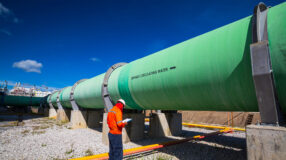Dear Chairman Rush, Ranking Member Upton, and Members of the Subcommittee:
The Interstate Natural Gas Association of America (INGAA) appreciates the opportunity to submit this testimony regarding the 2019 reauthorization of the Pipeline Safety Act. INGAA is a trade association that represents the interstate natural gas pipeline industry.
INGAA’s members transport the vast majority of the natural gas consumed in the United States through a network of approximately 200,000 miles of interstate transmission pipelines. These transmission pipelines are analogous to the interstate highway system; in other words, they are large capacity, critical infrastructure systems spanning multiple states or regions.
INGAA’s members bring the nation’s natural gas to market. That natural gas is used to heat our homes, cook our food, power our nation’s industries and generate electricity in an environmentally responsible manner.
INGAA asks that the subcommittee consider four principal points in its deliberations regarding reauthorization of the Pipeline Safety Act:
First, INGAA members will continue to incorporate new technologies and advanced engineering practices that enhance our pipeline safety performance. As an industry, we are relentlessly committed to transporting natural gas in a safe, reliable, and environmentally responsible manner. Not only does this make good business sense, but far more importantly, it is core to our function as operators of critical infrastructure. We are obligated to the communities we serve and in which we live to operate safely, reliably, and responsibly.
Second, our members support sensible regulation and completion of pending rulemakings in a timely and workable fashion. It is critical for an infrastructure industry of our national importance to have regulatory certainty. Regulatory certainty fuels improvements to safety performance, supports ongoing investment, and sustains and creates jobs.
As you know, the Department of Transportation is finalizing a rulemaking to fulfill many of the gas transmission pipeline safety mandates that were at the center of the last two Pipeline Safety Act reauthorizations. All told, this rulemaking represents the most significant enhancement to gas transmission pipeline safety regulations since the federal code was first promulgated in 1970. INGAA members strongly support prompt completion of these new regulations.
INGAA applauds PHMSA for picking up the pace on this rulemaking within the last few years. Nevertheless, INGAA recommends that in the future PHMSA pursue more precise rulemakings, instead of the single, omnibus rulemaking that was used for the pending gas transmission safety rules. We believe this approach would expedite future rules.
Third, the PHMSA Gas Pipeline Advisory Committee (GPAC) process has proven effective in facilitating broad stakeholder review of proposed regulations. The GPAC should remain an active participant in PHMSA’s work. The GPAC is a transparent and balanced forum that has demonstrated the ability to build consensus around complex regulatory issues, including the pending gas transmission pipeline safety regulations. In fact, several organizations that participated in the GPAC meetings recently sent a letter to Secretary Chao to express our support for expeditiously publishing a final gas transmission rule to address the outstanding congressional mandates. The signatories included INGAA, other pipeline trade associations, and public safety advocacy groups. Such consensus would not have been possible prior to the GPAC discussions.
Fourth, outdated regulations that do not reflect current technologies and engineering practices should be updated. These outdated regulations result from a code of federal standards established over the past 50 years, one rulemaking at a time. While those regulations reflect the technology and best thinking available at the time of adoption, they have not kept pace with advances in pipeline safety technology and modern engineering practices.
As an example, PHMSA should be commended for considering updates to the class location change regulations. With today’s processes and technologies, pipeline safety can be managed effectively through data-driven inspection and maintenance, instead of the haphazard pipe replacements required by the current class location change regulations. These unnecessary replacement projects can disrupt natural gas service and require the release of up to 800 million standard cubic feet of natural gas every year, which is equivalent to the annual natural gas use of over 10,000 homes and the annual greenhouse gas emissions of over 80,000 passenger vehicles. And each year the class location change regulations divert hundreds of millions of dollars towards replacing less than 75 miles of pipe. There are much more productive ways to invest these substantial resources to enhance pipeline safety. For example, we could instead assess 25,000 miles with internal inspection devices for the same cost of replacing 75 miles.
Congress directed PHMSA to consider updating the class location change regulations in prior reauthorizations. We hope Congress will continue to support this much-needed update.





